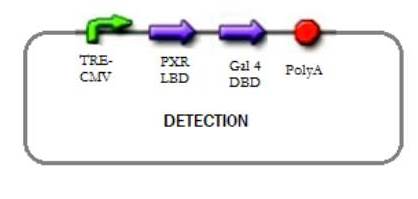Team:BIOSINT Mexico/Sensor
From 2013.igem.org
Sensor
Xenobiotics Sensor
- The sensor consists in the application of the model development by Debrecen in 2010, using nuclear receptors as transcriptional factors1 . The family of nuclear receptors are composed by a series of proteins which acts like sensor for lipids, steroids, hormones,endocrine-disrupting chemicals, etc.2
- Several xenobiotic substances are present in the intestine and many of them result toxic for the host. One example is organochlorine pesticide, a endocrine-disrupting chemical, which is a molecule that can be found on contaminated food and represent an important toxicity source. Detection and decrease levels of pesticide could be an effective way to solve the problem .3
- Nuclear receptors are ligand specific, and are composed by two basis domains: ligand binding domain (LBD) and DNA binding domain (DBD).2 In our sensor we adapt and characterized Debrecen system, which fuses specific LBD with Gal 4 DBD. 1
- The system adapt TRE-CMV promoter; that has a basal expression in the absence of TetR, Gal 4; yeast transcription factor galactose 4, PXR ligand binding domain which binds organochlorine and PolyA; important for nuclear export. The complete system will be expressed in one plasmid. 1
- Finally the nuclear receptor will interact with UAS, using Gal4 as specific binding region. UAS and Gal-4 forms a complex which activate the expression of the L.plantarum promoter. Development of specific nuclear receptors helps to quantify accurately the expression of the report product in relation with the ligand concentration. 4
- The probiotic sensor detect organochlorine, then the nuclear receptor complex activates the promoter for the expression of linA enzyme, which catalyze the conversion of γ-hexachlorocyclohexane to 1,2,4-trichloro benzene.5Using this method our probiotic is not only available to detect organochlorine pesticides but also degrade capabilities of the molecule, contributed to decrease the presence of the toxic molecule .
REFERENCES
1.iGEM Debrecen (2010).Recovered from https://2010.igem.org/Team:Debrecen-Hungary/favorite
2. Willson, T. et al.(2002) PXR, CAR and drug metabolism. Nature Publishing group: Volume 1
3.Kojima, H, et al. (2010). Endocrine- disrupting potential of pesticides via nuclear receptors and aryl hidrocarbon receptor. Journal of health science.
4. Elliot, D. & Brand A. (2002) The Gal4 system. Methods in molecular biology in Drosophila: A Fly Geneticist's Swiss Army Knife.
5.Yang, J, (2011). Construction of a Genetically Engineered Microorganism that Simultaneously Degrades Organochlorine and Organophosphate Pesticides. Appl Biochem Biotechnol.
 "
"





